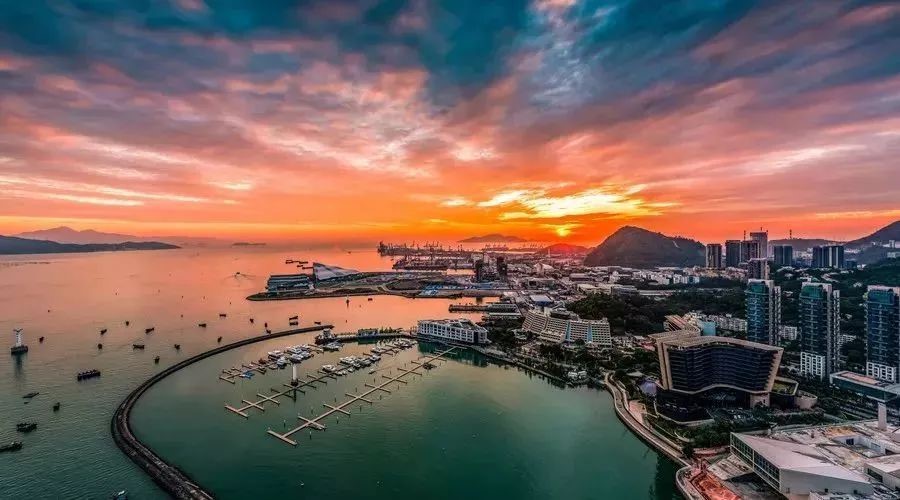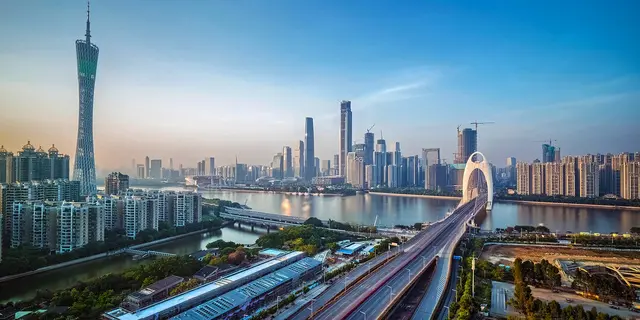By Mao Shunyu, Senior Researcher of Tianyi Digital Economy Institute
Translated by Xuye
In the context of the Belt and Road Initiative, the Guangdong-Hong Kong-Macao Greater Bay Area, as a pioneer of China’s economic development, reform and opening-up and innovation, plays an irreplaceable role in the construction of the Belt and Road Initiative and reshaping the pattern of the country’s opening up. It is also an important strategic hub for the Belt and Road Initiative. Therefore, it is necessary to fully grasp its geographic, industrial and development advantages, create a new area of growth of the regional economy, and speed up the development of open economy, striving to develop the Greater Bay Area into an innovation center for economic growth and a bridge linking China with the rest of the world, and a comprehensive platform for the building of the Belt and Road.
The Greater Bay Area enjoys very unique advantages in terms of geography, economy and politics. Therefore, efforts should be made to tap into its advantages, promote its integration with the national economic development, continuously improve its status and function in the country's economic development and opening-up, and maintain its long-term prosperity and stability.
First, geographic advantages. Located in the Pearl River Delta region with the West Straits Economic Zone to its east, the Yangtze River Economic Belt Zone to its north, and the Beibu Gulf to its west, the Greater Bay Area is a vast, well-developed region. Neighboring the South China Sea, it is an important shipping route linking the Indian Ocean and the Pacific Ocean, and a transport hub of the Asia-Pacific and even the world. It is also the south gate of China’s opening-up. As the starting point of the 21st Century Maritime Silk Road, the long coastline, port clusters, and vast sea areas provide unique geographical conditions for the development of the Greater Bay Area, which has gathered a large number of economic factors and forms a complete industrial system. The sound, open economic environment of the Greater Bay Area and the well-developed international network play an important role in the construction of the Belt and Road.
Second, industrial advantages. The “9+2” city clusters in the Greater Bay Area, composed of 9 cities in the Pearl River Delta region, and Hong Kong and Macao special administrative regions, is a typical world-class urban agglomeration, and one of the most dynamic and highly open regions in China. Advanced manufacturing and modern service sectors are pillar industries of the Greater Bay Area. Each of the 11 cities has its distinctive advantages with clear positioning and relatively complete industrial division of labor. The nine cities in the Pearl River Delta region boast complete industrial systems, large amounts of investment in scientific research, strong technological innovation capabilities, and solid manufacturing base, which make them become the world’s factory. The modern service industry is a pillar industry of Hong Kong and Macao. Hong Kong, as an international financial center, has a perfect financial system and shipping system. It also has developed trade, logistics, education, medical care, law and other service industries. Macao is a world tourism and leisure center and a platform for cooperation between China and Portuguese-speaking countries. All in all, the industrial pattern featuring a complete industrial chain and complementary advantages has laid a solid foundation and created conditions for the further industrial integration and coordinated development among cities in the Greater Bay Area.
Third, development advantages. In the context of Belt and Road Initiative, the construction of the Greater Bay Area as a national strategy gets strong national support. The Greater Bay area has always been the bellwether in China’s opening-up. Used to be a pathfinder for the country's reform and opening up, it now plays a new role in all-round opening up. At the policy level, the construction gets support from top-level design, with the region being positioned as a diversified, multi-center, multi-hub urban agglomeration featuring clear division of labor and sound cooperation. By removing institutional barriers, putting preferential policies in place and setting up an innovative cross-border mechanism, the Greater Bay Area has registered rapid economic growth and gained strong economic strengths. At the institutional level, effective, flexible institutional arrangements in three independent customs areas of Guangdong, Hong Kong and Macao facilitate cooperation between the Greater Bay Area and countries along the Belt and Road route, which is a good example of the practice of "One Country, Two Systems." The arrangements also help the Greater Bay Area expand their trade and industrial cooperation with the rest of the world, and provide convenience to Mainland enterprises to go global. Its open development and institutional innovation in the Greater Bay Area have become an important foundation and advantage for building a world-class bay area.

As an economic carrier for China’s high-quality development and a fresh attempt to setting up a new pattern for all-round opening up, the Greater Bay Area possess boundless potential for future development. Therefore, in the context of the Belt and Road Initiative, it will embark on a correct development path, and seize opportunities with a pioneering spirit, open mind, and diversified ideas, striving to build itself as an international technological innovation center. It will serve as a bridge linking between Chinese mainland and the rest of the world, and a comprehensive service platform for building the Belt and Road Initiative, developing itself as the world's leading bay area.
First, innovation is the driving force of economic growth. In the future, efforts should be made to build the Greater Bay Area as an international scientific and technological innovation center. On the one hand, it is necessary to expand space for technological innovation, build the Guangzhou-Shenzhen-Hong Kong-Macao technological innovation corridor and the technological industry belt, play a leading role in basic scientific research and innovation, accelerate the construction of a collaborative innovation service system and a shared platform for technological innovation resources, enhance cooperation on technological innovation. It should also improve technological applications by tapping into complementary advantages of different places, achieve industrial upgrade and all-round innovation, in an attempt to promote technological innovation in the Greater Bay Area; On the other hand, efforts should be made to improve the supporting innovation system for technological innovation, accelerate the construction of strategic emerging industrial clusters, upgrade information infrastructure in the Greater Bay Area, and create a sound environment for scientific and technological innovation talents. It should strengthen financial integration with science and technology, vigorously develop technology and financial industries in the Greater Bay Area, and better play the role of boosting technological innovation.
Second, opening-up is a requisite for sustainable development. In the future, the Greater Bay Area will become a bridge between the Chinese mainland and the world. On the one hand, it is necessary to improve the business environment for foreign companies. It should benchmark standards of world-class bay areas in terms of business startups, construction permits, loans, cross-border trade, gradually form a rule-based, international, fair and easy business environment, formulate policies to smooth traffic, logistics, capital and information channels, improve the institution and system to fit for international investment and trade rules, and establish a new open economic system in line with international standards; On the other hand, the Greater Bay Area should further integrate the Belt and Road Initiative with further opening-up, allowing Chinese enterprises to go global. As the most typical export-oriented economic region and an important window for opening-up to the outside world, the Greater Bay Area should encourage Mainland enterprises to leverage Hong Kong and Macao’ advantages to go global, strengthen business cooperation with countries participating in the Belt and Road Initiative, let the world know and love “Made in China" products, and forge close ties between the Chinese mainland and the rest of the world.
Third, service is an important pillar for Chinese companies going global. Setting up a comprehensive service platform for the Belt and Road in the Greater Bay Area will smooth the flow of resource elements. Insufficient ability to participate in international rulemaking, lack of professional talents, financial constraints, insufficient export-oriented public service, and lack of international intermediary services are the obstacles to Mainland enterprises in going global. Therefore, as the forerunner of the Belt and Road Initiative, the Greater Bay Area should explore the effective international service in terms of industrial resource integration, personnel training and exchanges, and international cooperation. It should also integrate resources of enterprises and universities in the region by taking advantages of its geographical, industrial and development advantages. The comprehensive service platform should offer a package of services ranging from policy consultation, production capacity matchmaking, financial support, to cultural exchanges, allowing different resource elements to give their full roles.
Fourth, Guangdong Province should focus on building a high-level, integrated regional cooperation platform and a modern industrial system with strong competitiveness. Guangdong, as a pioneering area in the country's reform and opening up, is a manufacturing powerhouse and an industrial development highland in China, as well as a large province of import and export trade with countries participating in the Belt and Road Initiative. The nine major cities in the province, with clear positioning, different industrial divisions of labor, a high degree of marketization and high-density industrial clusters, have formed the west-coast technology-intensive high-end manufacturing industry belt in northern and southern Guangzhou, Zhongshan, Foshan and Zhuhai, and the east-coast knowledge-intensive industrial belt in central and eastern Guangzhou, Dongguan and Shenzhen. In the future, Guangdong should provide industrial support for Hong Kong and Macao, and encourage more local enterprises to go global by making use of advantages of Hong Kong and Macao in finance, trade and investment, At the same time, it should enhance cooperation with Hong Kong and Macao, draw on their strengths, promote the rapid, orderly flow of talents, goods, capital, and information, improve technological and industrial innovation, and build an advanced manufacturing and modern service industry base. It should also build an open, integrated regional collaborative innovation community and an internationally competitive modern industrial system, which will surely contribute more to the development of the Greater Bay Area!
(ASIA PACIFIC DAILY)
 简体中文
简体中文





